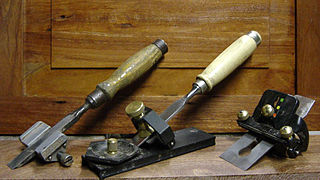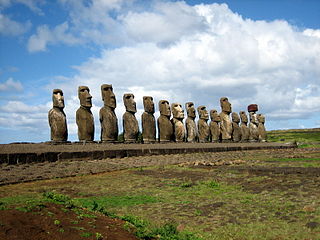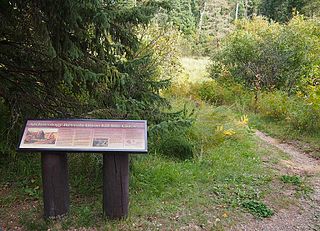
Alabaster is a mineral or rock that is soft, often used for carving, and is processed for plaster powder. Archaeologists and the stone processing industry use the word differently from geologists. The former use it in a wider sense that includes varieties of two different minerals: the fine-grained massive type of gypsum and the fine-grained banded type of calcite. Geologists define alabaster only as the gypsum type. Chemically, gypsum is a hydrous sulfate of calcium, while calcite is a carbonate of calcium.

Marble is a metamorphic rock composed of recrystallized carbonate minerals, most commonly calcite or dolomite. Marble is typically not foliated (layered), although there are exceptions. In geology, the term marble refers to metamorphosed limestone, but its use in stonemasonry more broadly encompasses unmetamorphosed limestone. Marble is commonly used for sculpture and as a building material.

A chisel is a tool with a characteristically shaped cutting edge of blade on its end, for carving or cutting a hard material such as wood, stone, or metal by hand, struck with a mallet, or mechanical power. The handle and blade of some types of chisel are made of metal or of wood with a sharp edge in it.

Marble has been the preferred material for stone monumental sculpture since ancient times, with several advantages over its more common geological "parent" limestone, in particular the ability to absorb light a small distance into the surface before refracting it in subsurface scattering. This gives an attractive soft appearance that is especially good for representing human skin, which can also be polished.

Stonemasonry or stonecraft is the creation of buildings, structures, and sculpture using stone as the primary material. It is one of the oldest activities and professions in human history. Many of the long-lasting, ancient shelters, temples, monuments, artifacts, fortifications, roads, bridges, and entire cities were built of stone. Famous works of stonemasonry include the Egyptian pyramids, the Taj Mahal, Cusco's Incan Wall, Easter Island's statues, Angkor Wat, Borobudur, Tihuanaco, Tenochtitlan, Persepolis, the Parthenon, Stonehenge, the Great Wall of China, and Chartres Cathedral.
Uchen is the upright, block style of the Tibetan script. The name means "with a head," and is the style of the script used for printing and for formal manuscripts.

Stone carving is an activity where pieces of rough natural stone are shaped by the controlled removal of stone. Owing to the permanence of the material, stone work has survived which was created during our prehistory or past time.

An air hammer, also known as an air chisel, is a pneumatic hand tool used to carve in stone, and to break or cut metal objects apart. It is designed to accept different tools depending on the required function.

Scary sharp is a method of sharpening woodworking tools with sandpaper instead of conventional methods of oilstone or waterstone sharpening. The sandpaper referred to here can be any abrasive impregnated sheet used in the various industries to smooth surfaces and examples include glass paper, silicon carbide, emery cloth, etc. The sandpaper is affixed to another hard, flat substrate to create the sharpening surface. Sheet-glass is commonly used, but a machinist's granite surfacing block, marble baking slabs, plywood, medium-density fibreboard (MDF) or even jointer out-feed tables will produce satisfactory results. The method of fixation is usually a matter of the user's preference, and can include plain water, sprayed-on adhesive, or by simply using adhesive-backed abrasive paper. This is exactly the same method as that used by materials scientists in preparing polished samples for metallography.

Breakfast at Sweethearts is the second studio album by Australian pub rock band Cold Chisel, released in February 1979. It spent 32 weeks in the national charts, reaching a peak of number 4.

A stone sculpture is an object made of stone which has been shaped, usually by carving, or assembled to form a visually interesting three-dimensional shape. Stone is more durable than most alternative materials, making it especially important in architectural sculpture on the outside of buildings.
Pont d'Iéna is a bridge spanning the River Seine in Paris. It links the Eiffel Tower on the Left Bank to the district of Trocadéro on the Right Bank.

Battle of the Centaurs is a relief sculpture by the Italian Renaissance artist Michelangelo, created around 1492. It was the last work Michelangelo created while under the patronage of Lorenzo de' Medici, who died shortly after its completion. Inspired by a classical relief created by Bertoldo di Giovanni, the marble sculpture represents the mythic battle between the Lapiths and the Centaurs. A popular subject of art in ancient Greece, the story was suggested to Michelangelo by the classical scholar and poet Poliziano. The sculpture is exhibited in the Casa Buonarroti in Florence, Italy.
Calvin Fletcher is a public artwork by an unknown artist, located inside the Indiana Statehouse in Indianapolis, Indiana, United States. The marble bust depicts Calvin Fletcher (1798–1866), a man who settled in Indiana early in the state's history and went on to become an attorney and senator. The bust stands 47.5 inches high, has a width of 20 inches and a depth of 10.25 inches.

Death and the Sculptor, also known as the Milmore Monument and The Angel of Death and the Young Sculptor is a sculpture in bronze, and one of the most important and influential works of art created by sculptor Daniel Chester French. The work was commissioned to mark the grave in Forest Hills Cemetery in Jamaica Plain, Boston, Massachusetts, of the brothers Joseph (1841–1886), James and Martin Milmore (1844–1883). It has two figures effectively in the round, linked to a background relief behind them. The right-hand figure represents a sculptor, whose hand holding a chisel is gently restrained by the fingers of the left-hand figure, representing Death, here shown as a winged female.

Pygmalion and the Image is the second series of four oil paintings in the Pygmalion and Galatea series by the Pre-Raphaelite artist Edward Burne-Jones which was completed between 1875 and 1878. The two collections may be seen below, in the Gallery, the first being now owned by Lord Lloyd Webber, and the second housed at the Birmingham Museum & Art Gallery. This article deals with an appraisal of the second series.

Stone carving in Odisha is the ancient practice of sculpting stone into art and utilitarian objects. It is an ancient practice in the Indian state of Odisha. Stone carving is practiced by artisans mainly in Puri, Bhubaneswar and Lalitgiri in the Cuttack district, though some carvings can be found in Khiching in the Mayurbhanj District. Stone carving is one of the major handcrafts of Odisha. The art form primarily consists of custom carved works, with the Sun Temple of Konark and its intricate sculpture and delicate carvings on the red vivid sandstone exemplifying the practice. Other noteworthy monuments include the Stupas of Udayagiri and Ratnagiri and the temples at Jagannath, Lingaraj, Mukteshwar and as well as other temples in the region.

Makrana marble is a type of white marble, popular for use in sculpture and building decor. It is mined in the town of Makrana in Rajasthan, India, and was used in the construction of several iconic monuments such as the Taj Mahal in Agra and the Victoria Memorial in Kolkata. The Makrana Marble is listed as a Global Heritage Stone Resource by International Union of Geological Sciences

The game drive system is a hunting strategy in which game are herded into confined or dangerous places where they can be more easily killed. It can also be used for animal capture as well as for hunting, such as for capturing mustangs. The use of the strategy dates back into prehistory. Once a site is identified or manipulated to be used as a game drive site, it may be repeatedly used over many years.

The Music Lesson is an oil painting by Frederic Leighton, first exhibited in 1877.

















